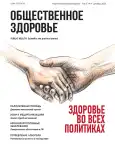The problem of anesthesia of regional society (on the example of the Republic of Mordovia)
- Authors: Kurmyshkina O.N.1, Motkin V.N.1
-
Affiliations:
- Scientific Center for Social and Economic Monitoring
- Issue: Vol 3, No 4 (2023)
- Pages: 16-24
- Section: Articles
- URL: https://journals.rcsi.science/2782-1676/article/view/252786
- DOI: https://doi.org/10.21045/2782-1676-2023-3-4-16-24
- ID: 252786
Cite item
Full Text
Abstract
About the authors
O. N. Kurmyshkina
Scientific Center for Social and Economic Monitoring
Email: mad-oksana@yandex.ru
V. N. Motkin
Scientific Center for Social and Economic Monitoring
Email: vlad.motkin@mail.ru
References
- Шереги Ф. Э. Социология девиации. Москва.: Юрайт, 2021. – 332 с.
- Федеральный закон «О наркотических средствах и психотропных веществах» от 8 января 1998 г. № 3-ФЗ (ред. от 17.07.2009, с изм. от 18.07.2009) // URL:https://www.consultant.ru/document/cons_doc_ LAW_17437/ (Дата обращения: 24.08.2023).
- Ишимова А. Е. Проблема наркомании в России // Молодой ученый. – 2020. – № 6. – С. 48–52.
- Доклад Федерального проекта “Трезвая Россия” о демографической ситуации в Российской Федерации 2020 г. // URL:https://alkogolunet.ru/demografija-2020.pdf?ysclid=ll24a1ymut467585573 (Дата обращения: 24.08.2023).
- Методика и порядок осуществления мониторинга, а также критерии оценки развития наркоситуации в Российской Федерации и ее субъектах (утв. подпунктом 4.3 решения Государственного антинаркотического комитета (протокол от 25 июня 2021 г. № 48)) // URL:https://www.garant.ru/products/ipo/prime/doc/401405228/?ysclid=ll2530t3zh439857896 (Дата обращения: 24.08.2023).
- Мониторинг наркоситуации в Республике Мордовия в 2022 г.: доклад //URL:https://e-mordovia.store.e-mordovia.ru/iblock/207/207633c497b72fcb085091dff5b71d1b/Doklad_Narkosituatsiya_za-2022.pdf (Дата обращения: 24.08.2023).
- Вишнякова Н. А., Курмышкина О. Н. Распространенность наркомании: субъективные оценки населения региона // Человек. Общество. Инклюзия. – 2021. – № 3 (47). – С. 26–31.
- В. В. Путин: «На новый уровень должна выйти борьба с наркобизнесом» // Наркоконтроль. – 2021. – № 2. – С. 3–5.
- Позднякова М. Е. Влияние Интернет-сообществ на распространение девиантных форм поведения в современной России (на примере наркотизма) // Россия реформирующаяся. Ежегодник / Отв. ред. М. К. Горшков. – Вып. 8. – М.: Институт социологии РАН, 2009. С. 128–149.
- Сидоров П. Г. Социальное окружение как фактор наркотизации молодежи (на примере Хабаровского края) // Власть и управление на Востоке России. – 2015. – № 3(72). – С. 102–108.
- Шинкевич В. Е., Бен Е. Н., Молоков В. В. Оценка факторов наркотизации социальной среды: по результатам ежегодного мониторинга наркоситуации в Красноярском крае // Вестник Сибирского юридического института МВД России. – 2020. – № 4 (41). – С. 171–181.
- Абсатаров Р. Р. 2021. Факторы, влияющие на состояние наркоситуации в субъектах Северо-Западного федерального округа России // Региональные геосистемы. – 2021. – 45(3). – С. 354–365. (С. 362).
- Доля граждан, систематически занимающихся физической культурой и спортом (Р5) // URL: https://www.fedstat.ru/indicator/61635 (Дата обращения: 24.08.2023).
- Кублова М. Г. Профилактика наркомании как основа безопасности и социальной стабильности государства// Наркоконтроль. – 2021. – № 2. – С. 26–30.
- Трезвая Россия – против наркотиков: рейтинг регионов //URL: http://www.trezvros.ru/calendar/798 (Дата обращения: 24.08.2023).
- Позднякова М. Е., Брюно В. В. Новые тенденции наркотизации как риски социетального характера // Вестник Института социологии. – 2018. – № 24. – C. 115–139.
- Социологический анализ наркоситуации в Республике Мордовия: бюллетень Научного центра социально-экономического мониторинга / В. Н. Мотькин, О. Н. Курмышкина, Т. Г. Маторкина; Государственное казенное учреждение Республики Мордовия «Научный центр социально-экономического мониторинга». Том № 2 (14). – Саранск: Национальный исследовательский Мордовский государственный университет им. Н. П. Огарёва, 2022. – 23 с.
Supplementary files








